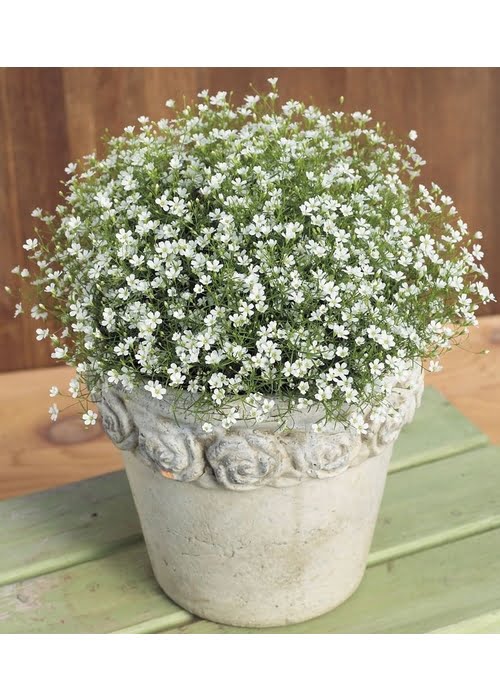Familiarity with specifications gypsophila
- Family : Clove
- Brands : Baby’s Breath, Gypsophila paniculata
- Origin : Eastern Europe to Western Siberia (Native: Eastern Mediterranean, Asia Minor)
- Plant height : 50 to 120 cm
- Flowering period : May to October
- Number of species : 140 species
Gypsophila flower consists of two parts : Gypse meaning gypsum and Philos meaning love, and the reason for this naming is the plant’s interest in calcareous soils. In fact, in Persian, the gypsophila flower is also called gypsum plant.
Baby’s breath plants ( Gypsophila spp. ) have become somewhat of a cliché in floral arrangements. But they also can look lovely in the garden. There are more than 100 annual and perennial species within this genus with varying appearances.
Some have a creeping growth habit, forming an attractive flowering ground cover. Their small, narrow leaves are gray-green to blue-green in color. In the summer, baby’s breath plants are covered in tiny, five-petaled, white or pink flowers that last several weeks.
Baby’s breath should be planted in the spring after the danger of frost has passed. The plants have a fast growth rate.
read more : Everything about lavender flower : How to Plant & care for them

Most gypsophila flower cultivars are perennials with white petals. Of course, blue, pink, purple or red can also be found. Gypsophila is also known in English as baby’s breath. In general, the only negative point of this plant can be its spicy aroma, which may not be very pleasant for some people. In fact, the smell of gypsophila is neither sweet nor bitter and in some cases can be odorless.
Selected species
There are about 150 species in the genus. Species include:
- Gypsophila acantholimoides
- Gypsophila achaia
- Gypsophila acutifolia – sharpleaf baby’s-breath
- Gypsophila adenophora
- Gypsophila adenophylla
- Gypsophila albida
- Gypsophila altissima
- Gypsophila antari
- Gypsophila antoninae
- Gypsophila arabica
- Gypsophila aretioides
- Gypsophila arrostii – Arrost’s baby’s-breath
- Gypsophila aucheri
- Gypsophila aulieatensis
- Gypsophila australis
- Gypsophila bicolor
- Gypsophila capituliflora
- Gypsophila caricifolia
- Gypsophila cephalotes
- Gypsophila davurica
- Gypsophila desertorum
- Gypsophila elegans – showy baby’s-breath
- Gypsophila fastigiata – fastigiate gypsophila
- Gypsophila glandulosa
- Gypsophila glomerata
- Gypsophila huashanensis
- Gypsophila imbricata
- Gypsophila intricata
- Gypsophila iranica
- Gypsophila krascheninnikovii
- Gypsophila libanotica
- Gypsophila licentiana
- Gypsophila litwinowii
- Gypsophila nana – dwarf gypsophila
- Gypsophila oldhamiana – Manchurian baby’s-breath, Oldham’s baby’s-breath
- Gypsophila pacifica
- Gypsophila paniculata – baby’s-breath, common gypsophila, panicled baby’s-breath
- Gypsophila patrinii
- Gypsophila perfoliata – perfoliate gypsophila
- Gypsophila petraea
- Gypsophila pilosa – Turkish baby’s-breath
- Gypsophila repens – alpine gypsophila, creeping baby’s-breath
- Gypsophila rokejeka
- Gypsophila ruscifolia
- Gypsophila scorzonerifolia – glandular baby’s-breath, garden baby’s-breath
- Gypsophila sericea
- Gypsophila silenoides
- Gypsophila simonii
- Gypsophila spergulifolia
- Gypsophila spinosa
- Gypsophila stevenii – Steven’s baby’s-breath
- Gypsophila struthium
- Gypsophila tenuifolia
- Gypsophila tschiliensis
- Gypsophila uralensis
- Gypsophila venusta
- Gypsophila viscosa
- Gypsophila wendelboi
- Gypsophila wilhelminae
- Gypsophila xanthochlora
read more : Everything about aster flower : How to Plant & care for them
Flowering time of gypsophila flower
The flowering period of the plant is from spring to early autumn.
Gypsophila flower care
gypsophila flowers generally require very little maintenance. Plant them in a spot that gets lots of light and has good soil drainage, and they’ll practically take care of themselves.
You’ll typically only need to water during dry spells and feed annually. Once your plants mature, you might need to provide them with support, such as garden stakes, to prevent the thin stems from flopping over. You also can proactively install stakes at the time of planting that the baby’s breath can grow around.
-
Light
Baby’s breath plants grow best in full sun, meaning at least six hours of direct sunlight on most days. But they will tolerate a bit of shade, especially from the hot afternoon sun. However, too much shade will result in leggy plants and poor flowering.
-
Soil
Baby’s breath plants can grow in a range of soil types, as long as they have good drainage. Sandy soil works well, whereas wet clay soil does not. So if your soil is heavy, consider planting baby’s breath in raised garden beds or containers. These plants also like a slightly alkaline soil pH, so if your soil is acidic, sweeten it with an application of garden lime.
-
Water
Baby’s breath has low water needs and thrives in dry soil. Keep the soil moderately moist for young plants. You typically won’t have to water established plants unless you have an extended period of drought. Overwatering can cause root rot and kill the plant.
-
Temperature and Humidity
Baby’s breath can tolerate a range of temperatures within its growing zones. Some species have more cold tolerance than others. These plants prefer a dry climate over a humid one. So if you have high humidity, it’s imperative to make sure your plant has excellent soil drainage and isn’t sitting in constant moisture.
read more : Everything about cosmos flower : How to Plant & care for them
-
Fertilizer
These plants aren’t heavy feeders, and too much fertilizer can cause floppy growth. To promote healthy growth and profuse blooms, simply work some compost into the planting site every spring.
Iran dried gypsophila flower
Gypsophila flower is one of the most beautiful flowers after rose, which has many uses. This flower stays fresh and lush for up to 5 days. But after this period, it does not wither, but begins to dry in the same way, and it can still be used inside the pot and on the table for decoration. Gypsophila flower is also used in some herbal medicines.
Dried gypsophila flowers is one of Iran’s export goods and has provided a great opportunity for Iranian traders to bring a lot of currency to the country by exporting dried gypsophila flower . Both types of gypsophila products can be exported either as fresh cut flowers or as dried flowers because each has its own customer.
The export of dried gypsophila flowers has provided a great opportunity for wholesalers and exporters of dried gypsophila flower and other plants to make significant profits.

read more : Drying natural flowers | Introducing 8 wonderful ways to dry flowers
Pruning gypsophila flower
These plants can be deadheaded by removing the spent blooms back to where the next spray is growing. They can also benefit from light pruning after the first flowering, which will help to maintain their shape.
After the second bloom, during the fall season, cut the stems of the perennial gypsophila flower to about one inch above the ground, for overwintering. The plant will come back in the spring.
Propagating gypsophila flower
gypsophila flower propagates easily and does it well from cuttings taken from a mature plant.
Here’s how :
- Cut pieces, about 4 to 5 inches, of healthy stems.
- Remove any leaves in the 1/3 portion of the lowest part of the cutting.
- Plant the cuttings in a small container filled with alkaline soil and mist often, keeping the soil moist, not soaked.
- The cuttings should be rooted in approximately four weeks, which you can then transplant outside.
read more : Everything about corn flower : How to Plant & care for them
How to grow gypsophila flower from seeds
This plant can be grown from seeds. Start by planting the seeds indoors in a seed-starting mix about six to eight weeks before planting in the spring. Keep the soil moist but not soggy, and seedlings should appear in about 10 to 14 days. Once the threat of frost has passed, you can transplant them in a sunny area of your garden.
While this plant is self-seeding, spreading about on its own, you can also directly sow the seeds into the garden. Plant them in a sunny, well-drained area, and cover them lightly with soil. Keep the soil moist but not overly wet. Plants should be spaced about 12 inches apart.
Common Pest & Plant Diseases
Gypsophila flower has a few issues with pests and diseases. Pests for this plant include aphids, leafhoppers, Japanese beetles, slugs. You might notice discolored leaves or holes in the leaves, which are an indication of a pest problem. There are non-chemical ways you can control some of these pests, such as a citrus spray or soap spray. Common diseases for baby’s breath include fungal infections and root rot, which can be caused by overwatering.
How to get gypsophila flower to bloom
Gypsophila is known for its tiny delicate flowers which bloom in late spring through the summer. To help this plant bloom better and longer, simply follow the pruning steps to help promote a second bloom and then winterize it before the first frost. The plant will come back each spring and rebloom every year.
read more : Everything about rose flower : How to Plant & care for them
Price of gypsophila flowers
The interesting thing about this flower is that it is cheap and that it is available to you all year round.
That’s why you can use it so easily. In warmer seasons, you can put the purchase of gypsophila flowers on your agenda. Because the price of gypsophila flower, like other flowers, is cheaper in warmer seasons and more expensive in colder seasons.
Notice : This article translated by google form Persian language. If you have any question or need more information please contact us or add a comment at the bottom of this page.

0 Comments